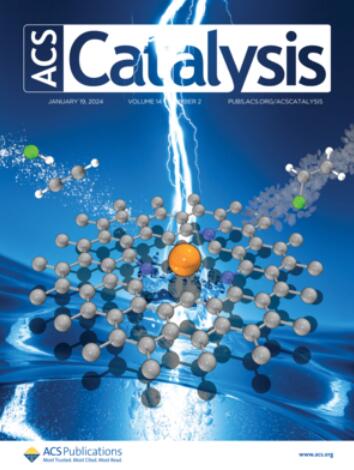Engineering Interfacial Oxygen Vacancies of Zn–Cr Sites for CO2 Activation and Hydrogenation
IF 11.3
1区 化学
Q1 CHEMISTRY, PHYSICAL
引用次数: 0
Abstract
Understanding the influence of oxygen vacancies is of great significance for revealing molecular adsorption and rational catalyst design. However, for the catalysts with multiple phases, the properties and intrinsic catalytic mechanism of oxygen vacancies on varied active sites have not been studied thoroughly. Herein, Zn–Cr catalysts with different oxygen vacancy distributions and contents are synthesized by engineering interfacial oxygen vacancies for CO2 hydrogenation. Characterization and DFT calculations illustrate that although the oxygen vacancies are not prone to being generated on the monointerface between ZnO and ZnCr2O4 compared with the spinel or metal oxide phases, the ZnO/ZnCr2O4–Ov interfacial oxygen vacancy sites reduce the energy barriers of crucial HCOO* and H3CO* intermediate formation for CH3OH synthesis. With the assistance of the well-dispersed interface oxygen vacancies, 3Zn1Cr displays the highest methanol selectivity (80.5%) as well as the highest CO2 conversion (19.2%) among all of the ratios of Zn–Cr catalysts. After further combination of 3Zn1Cr with modified β zeolite, the composite catalyst showed a superior liquefied petroleum gas selectivity of 84.0% at a CO2 conversion of 30.2%. The proposed strategy here sheds light on the efficient composite catalyst design via a methanol-mediated route for C1 chemistry.

求助全文
约1分钟内获得全文
求助全文
来源期刊

ACS Catalysis
CHEMISTRY, PHYSICAL-
CiteScore
20.80
自引率
6.20%
发文量
1253
审稿时长
1.5 months
期刊介绍:
ACS Catalysis is an esteemed journal that publishes original research in the fields of heterogeneous catalysis, molecular catalysis, and biocatalysis. It offers broad coverage across diverse areas such as life sciences, organometallics and synthesis, photochemistry and electrochemistry, drug discovery and synthesis, materials science, environmental protection, polymer discovery and synthesis, and energy and fuels.
The scope of the journal is to showcase innovative work in various aspects of catalysis. This includes new reactions and novel synthetic approaches utilizing known catalysts, the discovery or modification of new catalysts, elucidation of catalytic mechanisms through cutting-edge investigations, practical enhancements of existing processes, as well as conceptual advances in the field. Contributions to ACS Catalysis can encompass both experimental and theoretical research focused on catalytic molecules, macromolecules, and materials that exhibit catalytic turnover.
 求助内容:
求助内容: 应助结果提醒方式:
应助结果提醒方式:


